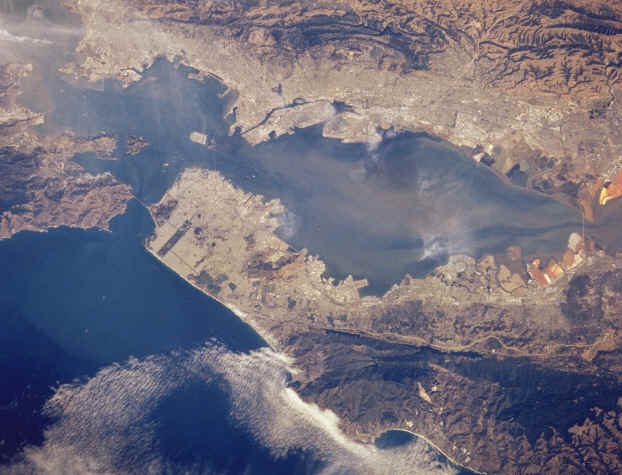|
Lindane in California
|

NASA San Fransisco Bay
|
California
Lindane Prohibition signed by Governor Gray Davis
California
Law
AMSA
Special Committees Address Top Issues
Surface Water: LINDANE BTM UG/KG
| Result |
# of Analysis |
# of Stations w/Analysis |
Units |
Min |
Max |
Average |
Std. Dev. |
| Detect |
3 |
2 |
u ug/kg |
.1 |
.8 |
.3667 |
.3786 |
| OSW* |
10 |
5 |
ug/l |
.005 |
.08 |
.0147 |
.023 |
| Detect |
5 |
1 |
ug/l |
.01 |
.02 |
.012 |
.0045 |
May 18, 2000 (65 Federal Register 31682)
www.epa.gov/fedrgstr/EPA-WATER/2000/May/Day-18/w11106.htm
Criterion Maximum Concentration for Freshwater = 950 ppt (set to protect
aquatic life)
Criterion Maximum Concentration for Saltwater = 160 ppt (set to protect aquatic
life)
Human Health Criterion for Consumption of Water and Organisms = 19 ppt
(set to protect human health at a one-in-a-million lifetime cancer risk, based
on a one-in-a-million lifetime cancer risk for a 70 kg person drinking 2 liters
of water per day and eating 6.5 grams per day of fish and shellfish)
Human Health Criterion for Consumption of Organisms only = 63 ppt
(set to protect human health at a one-in-a-million lifetime cancer risk, based
on a one-in-a-million lifetime cancer risk for a 70 kg person eating 6.5 grams
per day of fish and shellfish)
Technical Advisory Committee (TAC) Meeting for Lindane Reduction Project
On October 26, 1998, Regional Board staff attended the TAC meeting for
lindane reduction. The TAC was established by a grant from the US Environmental
Protection Agency (USEPA) to the County Sanitation Districts of Los Angeles
County (County San.) for lindane reduction efforts for publicly owned treatment
works (POTW). Lindane is problematic because lindane in effluent for many POTWs
exceeds US EPA water quality standards. The TAC is investigating measures to
reduce lindane in effluent. At this point, the main source of lindane appears to
be from formulations purchased off the shelf and administered in homes for head
lice. The meeting was attended by County Sanitation staff as well as
representatives from the City of Los Angeles, USEPA, and the National
Pediculosis Association. A pilot project for source control and reduction
efforts is being planned for one of the County San. plants with a small service
area.
Water Use and Management in Sonoma County, California
By Ilka M. Jerabek
Copyright 1996
Other toxic substances found to be bioaccumulating in the river watershed
include: arsenic, lindane, nickel, DDT, and lead at occasionally elevated
levels; chlordane, dieldrin, cadmium, DDE, chlorpyrifos, silver and zinc; and
copper in concentrations above those known to bring on chronic poisoning in
freshwater organisms. Recent sampling, expanded to include stations in the
southern county, revealed elevated levels of nickel, zinc, chromium, arsenic,
and copper from among samples taken from the Petaluma River, Sonoma Creek, and
the Estero Americano. (Please see Appendix C for more information on waterborne
toxics.)
http://www.sonoma.edu/people/norwick/Document/Jerabek/sowater7.html
California Resources:
MapCruzin.com
Californians for Pesticide
Reform
http://www.calhealthyschools.org/
|

